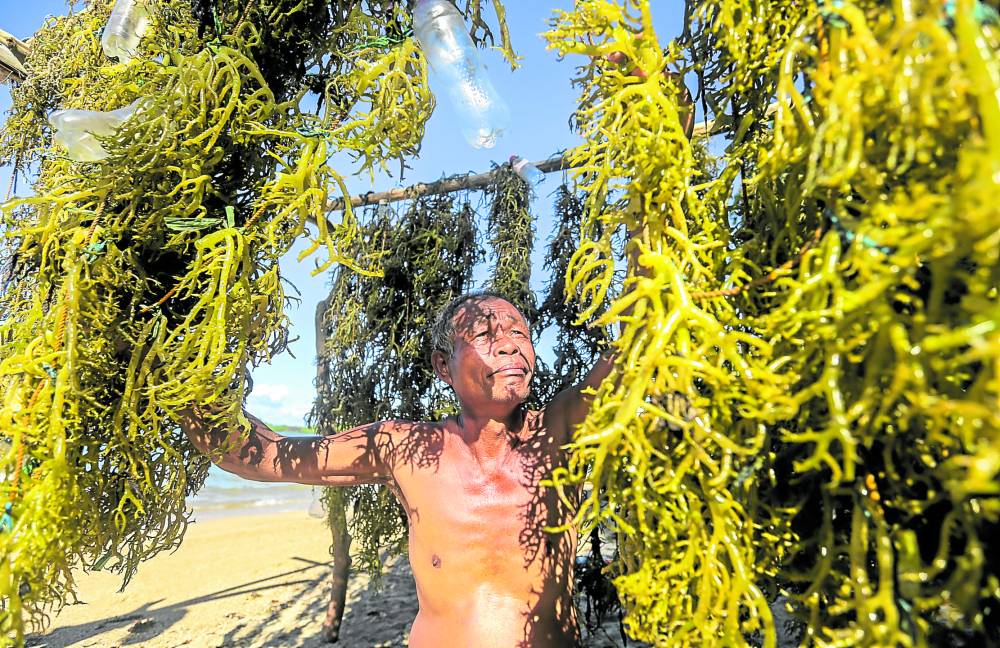Extreme heat stunts growth of seaweeds in CamSur town

HARVEST CHECK Fausto Amaro checks his newly harvested seaweeds in the village of Paniman in Caramoan, Camarines Sur, in this photo taken early this month. Amaro, 63, is worried that he may not recoup his capital as the seaweeds are stunted and of poor quality due to the extreme heat brought about by the El Niño. —MARK ALVIC ESPLANA
CARAMOAN, CAMARINES SUR—Fausto Amaro, 63, knew he would never get back his capital, let alone earn any profit, from his seaweed farm this year.
His seaweeds, which he propagates attached to ropes and makeshift floaters in the waters off Sitio Gogon in Barangay Paniman here, have become thin and short because of the extreme heat, Amaro said in an interview early this month.
He initially invested P35,000 to buy seaweed seedlings but he told the Inquirer that he thought he would barely earn P10,000.
Due to the extreme heat caused by the El Niño weather phenomenon, many of the seaweeds, locally called “gulaman,” rot before they are harvested or do not grow as long as Amaro expected.
He used to grow his seaweeds at least 24 inches, but now, these do not even reach 6 inches when he harvests them.
Article continues after this advertisementFrom being able to harvest between 200 and 500 kilos of seaweed, he would be lucky if he could harvest more than 200 kilos.
Article continues after this advertisementAmaro is just one of the 1,863 seaweed farmers here. They represent almost 3 percent of the population in this town in the northeastern part of Camarines Sur province.
Ma. Christina Sumpay, the town’s agriculturist, told the Inquirer on Monday that seaweed farmers here bring an estimated P25.5 million per year to the province’s coffers.
Heat index
On Tuesday, the Philippine Atmospheric, Geophysical and Astronomical Services Administration (Pagasa) forecast that the heat index in almost all Bicol provinces in the next few days would be between 41 and 46 degrees Celsius. Camarines Sur’s capital town of Pili recorded a heat index of 46 C on Wednesday.
Since the onset of a “strong” El Niño that was reported by Pagasa in December last year, the heat index in different areas around the country has hit 40 to 48 C this year. The index combines both the temperature and the humidity in a given area.
Amaro would, however, be forced to sell these stunted and dried seaweeds, despite their poor quality.
“When the gulaman is not struck with illness, we have more than enough harvest in a month. In three months, we would earn P50,000 despite the heat. Now, I will have to work harder to get even P10,000,” he told the Inquirer.
Amaro said local buyers would then sell their dried gulaman to other buyers in the Binondo district in Manila.
Sumpay said a portion of their seaweed harvest would be turned into gelatin, while the rest would be used to produce agar for cosmetics and medicine.
‘Survivor’
In order to supplement his income, Amaro now works as a part-time tourist guide.
Caramoan is famous among tourists, thanks to the publicity that the reality television show “Survivor” gave its white beaches and the islands of Bag-ing, Cagbanilad, Catanhawan, Cotivas, Lahus, Lahuy, Matukad, Minalahos, Pitogo and Sabitang-Laya.
In 2022, Caramoan welcomed 24,027 domestic and foreign tourists, according to data from the Department of Tourism in Bicol. This surged to 55,610 in 2023.
Jose Basister Rodriguez, the town government’s consultant on tourism affairs, said that there were many ways local fisherfolk and seaweed farmers could engage in tourism.
“Many of them have their own boats,” he said in a separate interview. “They are offering their boats to ferry tourists.”
Caramoan offers shorter trips for tourists who are only here for a day, but those who have time may opt for a “long trip,” where they can visit more islands. Some fishers sell their catch—usually fish, crab and lobsters—to tourists who sign up for these longer trips.
But Amaro has not completely given up on his seaweed farm. He said he sought training to be able to farm seaweed while adapting to the heat.
Jeva Hazel Antonio, Caramoan’s tourism officer, said that they were coordinating with other local government offices, like the Department of Trade and Industry, to train farmers so they can engage in small businesses, like production of taro chips.